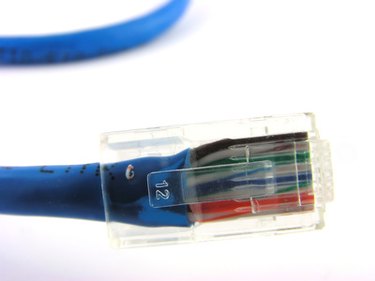
"Local Area Networks," or LANs, and "Wide Area Networks," or WANs, can both be defined by the network protocols that constitute them. Protocols are standards that define how data is ultimately transferred from one system to another. The difference between a LAN and a WAN is the distance the data travels, with a LAN typically serving a single building and a WAN usually covering different geograph locations.
LAN Protocols
Video of the Day
LAN protocols are distinguished by their capability to efficiently deliver data over shorter distances, such as a few hundred feet, through various mediums, such as copper cabling. Different protocols exist for different purposes and exist in different "layers" of the "Open Systems Interconnect," or OSI, model. Typically when using the word "LAN" to describe a protocol, the intent is to describe lower level, or physical, layers. Some of the most common LAN protocols are "Ethernet," "Token Ring" and "Fiber Distributed Data Interface," or "FDDI."
Video of the Day
"Ethernet" is by far the most common type of LAN protocol. It is found in homes and offices throughout the world and is recognizable by its common "CAT5" copper cable medium. It uses a switch or hub to which all systems connect to exchange data.
"Token Ring" is an older LAN technology that is not prevalent anymore. The basic premise of "Token Ring" is a single "token" is passed from system to system, or through a hub, and only the intended recipient reads the token.
"FDDI" defines how LAN traffic is transmitted over fiber cabling. Fiber cabling is used when longer distances, usually between floors or buildings, are required, or where heightened security is required.
WAN Protocols
WAN protocols are distinguished by their capability to efficiently deliver data over longer distances, such as hundreds of miles. This is generally required to bridge data between multiple LANs. The Internet is the world's largest WAN. Routers, modems and other WAN devices are used to transmit the data over various mediums, commonly fiber cabling. Some of the most common WAN protocols in use today are "Frame Relay," "X.25," "Integrated Services Digital Network," or "ISDN," and "Point-to-Point Protocol," or "PPP."
"Frame Relay" and "X.25" are similar in that they are both packet-switching technologies for sending data over large distances. "Frame Relay" is newer and faster, whereas "X.25" delivers data more reliably.
"PPP" is a protocol that is used to transmit data for other protocols over mediums that they would not normally support, such as sending the "Internet Protocol," or IP, over serial lines.
"ISDN" is a method of combining multiple dial-up lines on a public telephone network into a single data stream.
Wireless LAN Protocols
Wireless LANs, sometimes referred to as "WLAN" or "Wi-Fi," are becoming increasingly prevalent. They operate essentially the same as a traditional LAN, but use wireless signals between antennas as the medium, rather than cabling. Most of the wireless protocols in use today are based on the 802.11 standard and are differentiated by the letter appearing after the number. The four main protocols are "802.11a," "802.11b," "802.11g" and "802.11n."
"802.11a" is designed to carry data over shorter distances at higher speeds of up to 54 megabits per second, or Mbps. "802.11b" does the opposite, operating at lower speeds of up to only 11 Mbps but with higher reliability at longer distances and with more obstructing objects in the environment.
"802.11g" combines the best of the previous two protocols, operating at up to 54 Mbps over longer distances. "802.11n" is the latest wireless protocol to be released. It can operate at speeds of greater than 150 Mbps over longer distances than the other protocols.